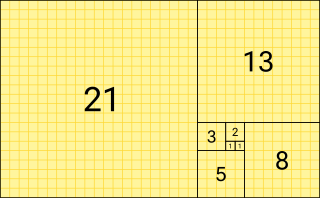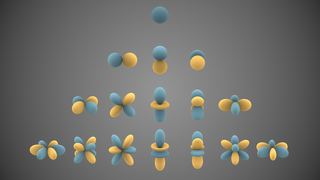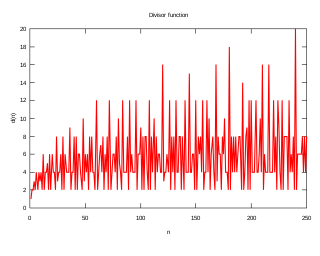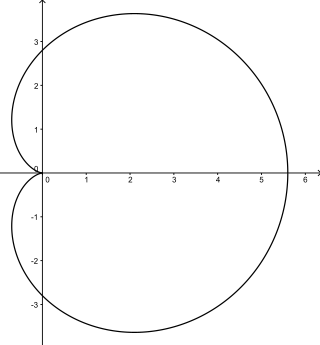
In mathematics, the Fibonacci sequence is a sequence in which each number is the sum of the two preceding ones. Numbers that are part of the Fibonacci sequence are known as Fibonacci numbers, commonly denoted Fn . The sequence commonly starts from 0 and 1, although some authors start the sequence from 1 and 1 or sometimes from 1 and 2. Starting from 0 and 1, the sequence begins

A Fourier series is an expansion of a periodic function into a sum of trigonometric functions. The Fourier series is an example of a trigonometric series, but not all trigonometric series are Fourier series. By expressing a function as a sum of sines and cosines, many problems involving the function become easier to analyze because trigonometric functions are well understood. For example, Fourier series were first used by Joseph Fourier to find solutions to the heat equation. This application is possible because the derivatives of trigonometric functions fall into simple patterns. Fourier series cannot be used to approximate arbitrary functions, because most functions have infinitely many terms in their Fourier series, and the series do not always converge. Well-behaved functions, for example smooth functions, have Fourier series that converge to the original function. The coefficients of the Fourier series are determined by integrals of the function multiplied by trigonometric functions, described in Common forms of the Fourier series below.

In mathematics, Legendre polynomials, named after Adrien-Marie Legendre (1782), are a system of complete and orthogonal polynomials with a vast number of mathematical properties and numerous applications. They can be defined in many ways, and the various definitions highlight different aspects as well as suggest generalizations and connections to different mathematical structures and physical and numerical applications.
In mathematical analysis, the Minkowski inequality establishes that the Lp spaces are normed vector spaces. Let be a measure space, let and let and be elements of Then is in and we have the triangle inequality

In mathematics and physical science, spherical harmonics are special functions defined on the surface of a sphere. They are often employed in solving partial differential equations in many scientific fields. A list of the spherical harmonics is available in Table of spherical harmonics.
Burnside's lemma, sometimes also called Burnside's counting theorem, the Cauchy–Frobenius lemma, or the orbit-counting theorem, is a result in group theory that is often useful in taking account of symmetry when counting mathematical objects. It was discovered by Augustin Louis Cauchy and Ferdinand Georg Frobenius, and became well-known after William Burnside quoted it. The result enumerates orbits of a symmetry group acting on some objects: that is, it counts distinct objects, considering objects symmetric to each other as the same; or counting distinct objects up to a symmetry equivalence relation; or counting only objects in canonical form. For example, in describing possible organic compounds of certain type, one considers them up to spatial rotation symmetry: different rotated drawings of a given molecule are chemically identical.

In mathematics, a Green's function is the impulse response of an inhomogeneous linear differential operator defined on a domain with specified initial conditions or boundary conditions.

The Lucas sequence is an integer sequence named after the mathematician François Édouard Anatole Lucas (1842–1891), who studied both that sequence and the closely related Fibonacci sequence. Individual numbers in the Lucas sequence are known as Lucas numbers. Lucas numbers and Fibonacci numbers form complementary instances of Lucas sequences.

In mathematics, and specifically in number theory, a divisor function is an arithmetic function related to the divisors of an integer. When referred to as the divisor function, it counts the number of divisors of an integer. It appears in a number of remarkable identities, including relationships on the Riemann zeta function and the Eisenstein series of modular forms. Divisor functions were studied by Ramanujan, who gave a number of important congruences and identities; these are treated separately in the article Ramanujan's sum.
In combinatorial mathematics, the necklace polynomial, or Moreau's necklace-counting function, introduced by C. Moreau (1872), counts the number of distinct necklaces of n colored beads chosen out of α available colors, arranged in a cycle. Unlike the usual problem of graph coloring, the necklaces are assumed to be aperiodic, and counted up to rotation, but without flipping over. This counting function also describes the dimensions in a free Lie algebra and the number of irreducible polynomials over a finite field.

The path integral formulation is a description in quantum mechanics that generalizes the stationary action principle of classical mechanics. It replaces the classical notion of a single, unique classical trajectory for a system with a sum, or functional integral, over an infinity of quantum-mechanically possible trajectories to compute a quantum amplitude.

In geometry, a cardioid is a plane curve traced by a point on the perimeter of a circle that is rolling around a fixed circle of the same radius. It can also be defined as an epicycloid having a single cusp. It is also a type of sinusoidal spiral, and an inverse curve of the parabola with the focus as the center of inversion. A cardioid can also be defined as the set of points of reflections of a fixed point on a circle through all tangents to the circle.
In mathematics, the Hilbert–Pólya conjecture states that the non-trivial zeros of the Riemann zeta function correspond to eigenvalues of a self-adjoint operator. It is a possible approach to the Riemann hypothesis, by means of spectral theory.

In mathematics, the Zernike polynomials are a sequence of polynomials that are orthogonal on the unit disk. Named after optical physicist Frits Zernike, laureate of the 1953 Nobel Prize in Physics and the inventor of phase-contrast microscopy, they play important roles in various optics branches such as beam optics and imaging.
In mathematics, in the areas of combinatorics and computer science, a Lyndon word is a nonempty string that is strictly smaller in lexicographic order than all of its rotations. Lyndon words are named after mathematician Roger Lyndon, who investigated them in 1954, calling them standard lexicographic sequences. Anatoly Shirshov introduced Lyndon words in 1953 calling them regular words. Lyndon words are a special case of Hall words; almost all properties of Lyndon words are shared by Hall words.
In combinatorial mathematics a cycle index is a polynomial in several variables which is structured in such a way that information about how a group of permutations acts on a set can be simply read off from the coefficients and exponents. This compact way of storing information in an algebraic form is frequently used in combinatorial enumeration.

In mathematics, a genus of a multiplicative sequence is a ring homomorphism from the ring of smooth compact manifolds up to the equivalence of bounding a smooth manifold with boundary to another ring, usually the rational numbers, having the property that they are constructed from a sequence of polynomials in characteristic classes that arise as coefficients in formal power series with good multiplicative properties.
In geodesy and navigation, a meridian arc is the curve between two points on the Earth's surface having the same longitude. The term may refer either to a segment of the meridian, or to its length.
The goat grazing problem is either of two related problems in recreational mathematics involving a tethered goat grazing a circular area: the interior grazing problem and the exterior grazing problem. The former involves grazing the interior of a circular area, and the latter, grazing an exterior of a circular area. For the exterior problem, the constraint that the rope can not enter the circular area dictates that the grazing area forms an involute. If the goat were instead tethered to a post on the edge of a circular path of pavement that did not obstruct the goat, the interior and exterior problem would be complements of a simple circular area.





























